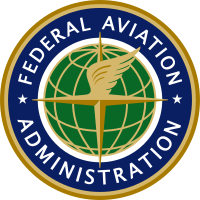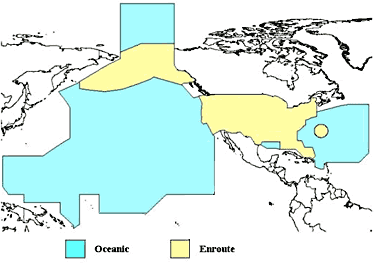
The Federal Aviation Administration (FAA) is a U.S. federal government agency within the U.S. Department of Transportation which regulates civil aviation in the United States and surrounding international waters. Its powers include air traffic control, certification of personnel and aircraft, setting standards for airports, and protection of U.S. assets during the launch or re-entry of commercial space vehicles, powers over neighboring international waters were delegated to the FAA by authority of the International Civil Aviation Organization.

Air traffic control (ATC) is a service provided by ground-based air traffic controllers (people) who direct aircraft on the ground and through a given section of controlled airspace, and can provide advisory services to aircraft in non-controlled airspace. The primary purpose of ATC worldwide is to prevent collisions, organise and expedite the flow of traffic in the air, and provide information and other support for pilots.
The Small Aircraft Transportation System (SATS) is a joint research project between the Federal Aviation Administration (FAA) and the National Aeronautics and Space Administration (NASA), along with local airports and aviation authorities. SATS is designed to facilitate transportation between small General Aviation airports, using small aircraft as an alternative to traditional airline travel.

Marion Clifton Blakey is an American businesswoman and former government official who served as president and CEO of Rolls-Royce North America. Prior to joining Rolls-Royce, she served as the eighth full-time chief executive of the Aerospace Industries Association, an American defense industry trade association from 2007 to 2015. Before this, she served a five-year term as the 15th Administrator of the Federal Aviation Administration. Blakey was the second woman to hold the position, serving as a successor to Jane Garvey, the first woman to hold the Administrator title. She was the second Administrator who was not a licensed pilot. She was awarded the Wright Brothers Memorial Trophy in 2013.

In air traffic control, an area control center (ACC), also known as a center or en-route center, is a facility responsible for controlling aircraft flying in the airspace of a given flight information region (FIR) at high altitudes between airport approaches and departures. In the US, such a center is referred to as an air route traffic control center (ARTCC).

An airport surveillance radar (ASR) is a radar system used at airports to detect and display the presence and position of aircraft in the terminal area, the airspace around airports. It is the main air traffic control system for the airspace around airports. At large airports it typically controls traffic within a radius of 60 miles (96 km) of the airport below an elevation of 25,000 feet. The sophisticated systems at large airports consist of two different radar systems, the primary and secondary surveillance radar. The primary radar typically consists of a large rotating parabolic antenna dish that sweeps a vertical fan-shaped beam of microwaves around the airspace surrounding the airport. It detects the position and range of aircraft by microwaves reflected back to the antenna from the aircraft's surface. The secondary surveillance radar consists of a second rotating antenna, often mounted on the primary antenna, which interrogates the transponders of aircraft, which transmits a radio signal back containing the aircraft's identification, barometric altitude, and an emergency status code, which is displayed on the radar screen next to the return from the primary radar.
System Wide Information Management (SWIM) is a global Air Traffic Management (ATM) industry initiative to harmonize the exchange of Aeronautical, Weather and Flight information for all Airspace Users and Stakeholders. SWIM is an integral part of the International Civil Aviation Organization (ICAO) Global Air Navigation Plan (GANP). The GANP defines 4 Performance Improvement Areas (PIA), SWIM resides in PIA 2: Globally interoperable systems and data, where its implementation is further defined in Aviation System Block Upgrades (ASBU) B1-SWIM and B2-SWIM. ASBU B1-SWIM defines SWIM as a “a net-centric operation where the air traffic management (ATM) network is considered as a series of nodes, including the aircraft, providing or using information.” it goes on to say “The sharing of information of the required quality and timeliness in a secure environment is an essential enabler to the ATM target concept.”

The Civil Aviation Authority of the Philippines is the civil aviation authority of the Philippines and is responsible for implementing policies on civil aviation to assure safe, economic and efficient air travel. The agency also investigates aviation accidents via its Aircraft Accident Investigation and Inquiry Board. Formerly the Air Transportation Office, it is an independent regulatory body attached to the Department of Transportation for the purpose of policy coordination.

The Boston Consolidated TRACON (A90) is located in Merrimack, New Hampshire. A90 opened in 2004 after 8 years of development. The A90 function transferred to the new Boston Consolidated TRACON on February 22, 2004. The MHT function transferred over on March 7, 2004. Manchester TRACON used to be located at Manchester Airport below the old ATCT. Boston TRACON used to be located at the Logan International Airport Control Tower before being consolidated. The new facility is 63,000 square feet (5,900 m2). A Terminal Radar Approach Control, or TRACON, is responsible for descending airplanes from the ARTCC and lining them up for landing at their destination airport, as well as climbing departures before handing off to the ARTCC.
The Next Generation Air Transportation System (NextGen) is an ongoing United States Federal Aviation Administration (FAA) project to modernize the National Airspace System (NAS). The FAA began work on NextGen improvements in 2007 and plans to finish the final implementation segment by 2030. The goals of the modernization include using new technologies and procedures to increase the safety, efficiency, capacity, access, flexibility, predictability, and resilience of the NAS while reducing the environmental impact of aviation.
The National Airspace System (NAS) is the airspace, navigation facilities and airports of the United States along with their associated information, services, rules, regulations, policies, procedures, personnel and equipment. It includes components shared jointly with the military. It is one of the most complex aviation systems in the world, and services air travel in the United States and over large portions of the world's oceans.

The Los Angeles Air Route Traffic Control Center is an air traffic control center located in Palmdale, California, United States. Located adjacent to United States Air Force Plant 42 and the Palmdale Regional Airport, it is one of 22 Air Route Traffic Control Centers (ARTCC) operated by the United States Federal Aviation Administration (FAA).

Automatic Dependent Surveillance–Broadcast (ADS-B) is an aviation surveillance technology and form of Electronic Conspicuity in which an aircraft determines its position via satellite navigation or other sensors and periodically broadcasts its position and other related data, enabling it to be tracked. The information can be received by air traffic control ground-based or satellite-based receivers as a replacement for secondary surveillance radar (SSR). Unlike SSR, ADS-B does not require an interrogation signal from the ground or from other aircraft to activate its transmissions. ADS-B can also receive point-to-point by other nearby equipped "ADS-B In" equipped aircraft to provide traffic situational awareness and support self-separation. ADS-B is "automatic" in that it requires no pilot or external input to trigger its transmissions. It is "dependent" in that it depends on data from the aircraft's navigation system to provide the transmitted data.
Next Generation (NextGen) Data Communications, an element of the Next Generation Air Transportation System, will significantly reduce controller-to-pilot communications and controller workload, whilst improving safety. NextGen comprises complex integrated and interlinked programs, portfolios, systems, policies, and procedures. NextGen has modernized air traffic infrastructure in communications, navigation, surveillance, automation, and information management.
The Professional Aviation Safety Specialists (PASS) is affiliated with the AFL–CIO through its affiliation with the Marine Engineers' Beneficial Association. It represents more than 11,000 Federal Aviation Administration's (FAA) Airway Transportation Systems Specialists and Department of Defense employees.
Mike Monroney Aeronautical Center is a regional office of the United States Federal Aviation Administration on the grounds of Will Rogers Airport in Oklahoma City. With around 7,500 direct federal employees, the Aeronautical Center is one of the Department of Transportation's largest facilities outside the Washington, DC area, and one of the 10 largest employers in the Oklahoma City metropolitan area. It is named for Senator Mike Monroney of Oklahoma, who wrote and sponsored the Federal Aviation Act of 1958.
The FAA William J. Hughes Technical Center is an aviation research and development, and test and evaluation facility. The Technical Center serves as the national scientific test base for the Federal Aviation Administration. Technical Center programs include research and development, test and evaluation, and verification and validation in air traffic control, communications, navigation, airports, aircraft safety, and security. They also include long-range development of aviation systems and concepts, development of new air traffic control equipment and software, and modification of existing systems and procedures. Through a series of initiatives known collectively as NextGen, the Technical Center is contributing to the Next Generation Air Transportation System.

The Aviation Innovation, Reform, and Reauthorization (AIRR) Act was a bill introduced on February 3, 2016, in the 114th Congress (2015-2016) by Congressman Bill Shuster (R-PA) and Frank LoBiondo (R-NJ). Among other things, the bill would have privatized the American air traffic control (ATC) system. The bill would also have reauthorized the Federal Aviation Administration (FAA) through 2019.
The Cape TRACON (K90) is a radar approach facility located at Joint Base Cape Cod, Massachusetts next to the airfield for Coast Guard Air Station Cape Cod. It is operated by the Federal Aviation Administration (FAA).

Airway Transportation Systems Specialists', also known as (ATSSs; FV-2101) are Systems Electronics Technicians assigned to the Technical Operations (TechOps) section of the Federal Aviation Administration's Air Traffic Organization (ATO). Airway Transportation Systems Specialists possess theoretical and practical knowledge in electronic theory and characteristics, functions, operations, and capabilities of a variety of National Airspace System (NAS) systems. Airway Transportation Systems Specialists ensure the safety and efficiency of the NAS by performing preventive maintenance, corrective maintenance, and system modifications of air traffic control systems at ATCTs, TRACONs, and ARTCCs throughout the United States of America and its territories. ATSS generally possesses years of experience in a variety of U.S. National Airspace System (NAS) systems. Airway Transportation Systems Specialists are responsible for the maintenance, operation, fabrication, installation, and management of the technical infrastructure of the National Airspace System. Airway Transportation Systems Specialists work at different Systems Support Centers (SSCs) in the United States. Airway Transportation Systems Specialists install, maintain, repair, operate, and monitor hardware and software to ensure they work as designed. ATSS certifies equipment and services to ensure safe and efficient flight operations throughout NAS. The FAA workforce currently includes 5,200 ATSS nationwide.












